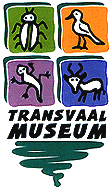
E - MAIL
Dr
Principal Researcher
Dr
Researcher
Collection Manager
Preparator
Palaeontology
"MRS PLES": OUR DISTANT RELATIVE
By Dr Francis Thackeray
Principal Researcher: Human Origins and Past Environments
Transvaal Museum

Who was "Mrs Ples" ?
"Mrs Ples" is the nickname of a fossil skull which is believed by many scientists to represent a distant relative of all humankind.
The skull of "Mrs Ples" was discovered at the Sterkfontein Caves, near Krugersdorp, on April 18, 1947. The discovery was made by Dr Robert Broom of the Transvaal Museum, with his assistant, John Robinson.
"Mrs Ples" and her relatives lived on the South African highveld between about 2 and 2.5 million years ago. "Mrs Ples" is the most complete cranium of the species Australopithecus africanus. Formerly the skull was known as "Plesianthropus" which means "almost human". "Mrs Ples" is almost human in the sense that she could walk upright, like humans, but she had a small brain, similar in size to that of a modern chimpanzee.
Scientists believe that humans and chimpanzees had a common ancestor, which lived on the African continent many millions of years ago. As a distant relative of all humankind, "Mrs Ples" is more closely related to humans than to modern chimpanzees.
|
PRICE LIST FOR FOSSIL CASTS (US Dollars) - 2003 click |
|
|
Who were the australopithecines ?
Australopithecus africanus is the scientific name of ape-like human creatures that lived on the African continent more than 2 million years ago. The first skull of this species, discovered in 1924 at Taung about 120 kilometres north of Kimberley, was described by Professor Raymond Dart of the University of the Witwatersrand. Between 1936 and 1960, many other fossils of the same species were discovered at Sterkfontein by Dr Robert Broom and Dr John Robinson. Yet more were specimens of Australopithecus africanus were subsequently discovered at Sterkfontein by Professor P.V. Tobias and his colleagues at the University of the Witwatersrand, including the late Alun Hughes and Dr Ron Clarke. With Stephen Motsumi and Nkwane Molefe, Dr Clarke recently discovered a complete skeleton of Australopithecus in cave deposits which are 4.2 million years old.
Another species of Australopithecus is called Australopithecus robustus. The first specimen of this species was discovered by a schoolboy in 1938 at Kromdraai, where excavations are currently being undertaken by Francis Thackeray of the Transvaal Museum. Many other specimens of the same species have been discovered at Swartkrans excavated by Dr Bob Brain, former Director of the Transvaal Museum, and at Drimolen excavated by Dr Andre Keyser. The "robust" australopithecines had large molar teeth, and broad flat faces. They lived between 2.0 and 1.5 million years ago in the Sterkfontein area, and were similar to another species, called Australopithecus boisei, which has been found in East Africa.
Who were Homo habilis, Homo erectus and Homo ergaster ?
Homo habilis is the name of a hominid species which lived on the African continent about 1.8 million years ago. It is believed to be an ancestor for Homo erectus, a species which is known to have made stone tools called hand-axes about 1 million years ago. Homo erectus is known to have lived in Asia. Its African counterpart is called Homo ergaster.
In South Africa, Homo ergaster made stone tools and may have had the ability to control fire within the period between about 1.5 and 1 million years ago. With the controlled use of fire, hominids could keep leopards at bay. Some hominids are likely to have been victims of leopard predation.
Both Homo ergaster and Australopithecus robustus were omnivorous. They ate plant food and animal protein. Edible plants in their diet probably included fruits and the bulbs of plants such as Hypoxis which they probably dug up with bone tools. Bone tools were used to open up termite mounds.
The Transvaal Museum has public displays which feature replicas of the species described here, and reconstructions of "a day in the life of an australopithecine". The displays serve to promote an awareness of South Africa’s rich palaeontological heritage, which is part of world heritage.
